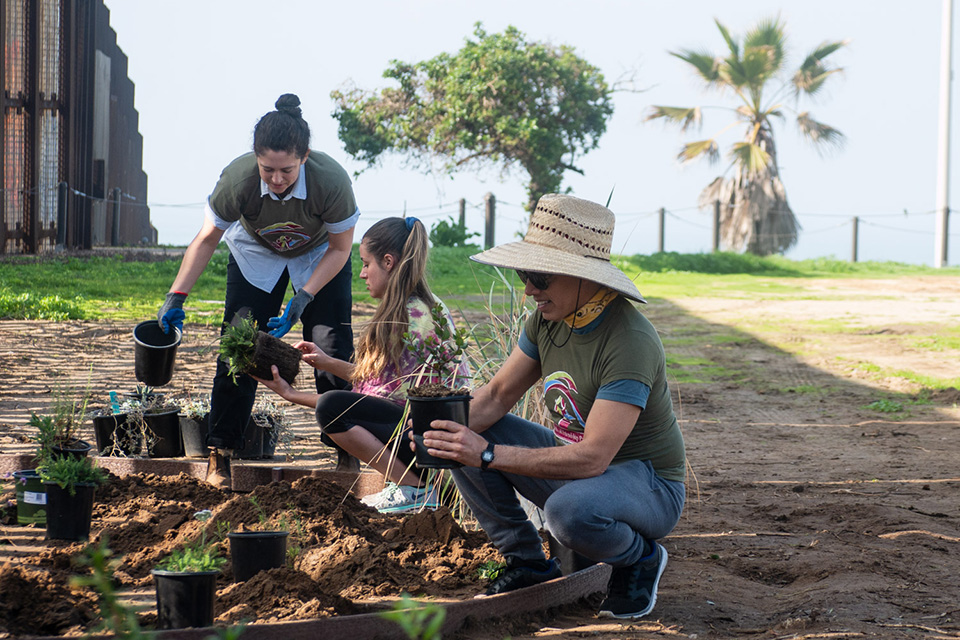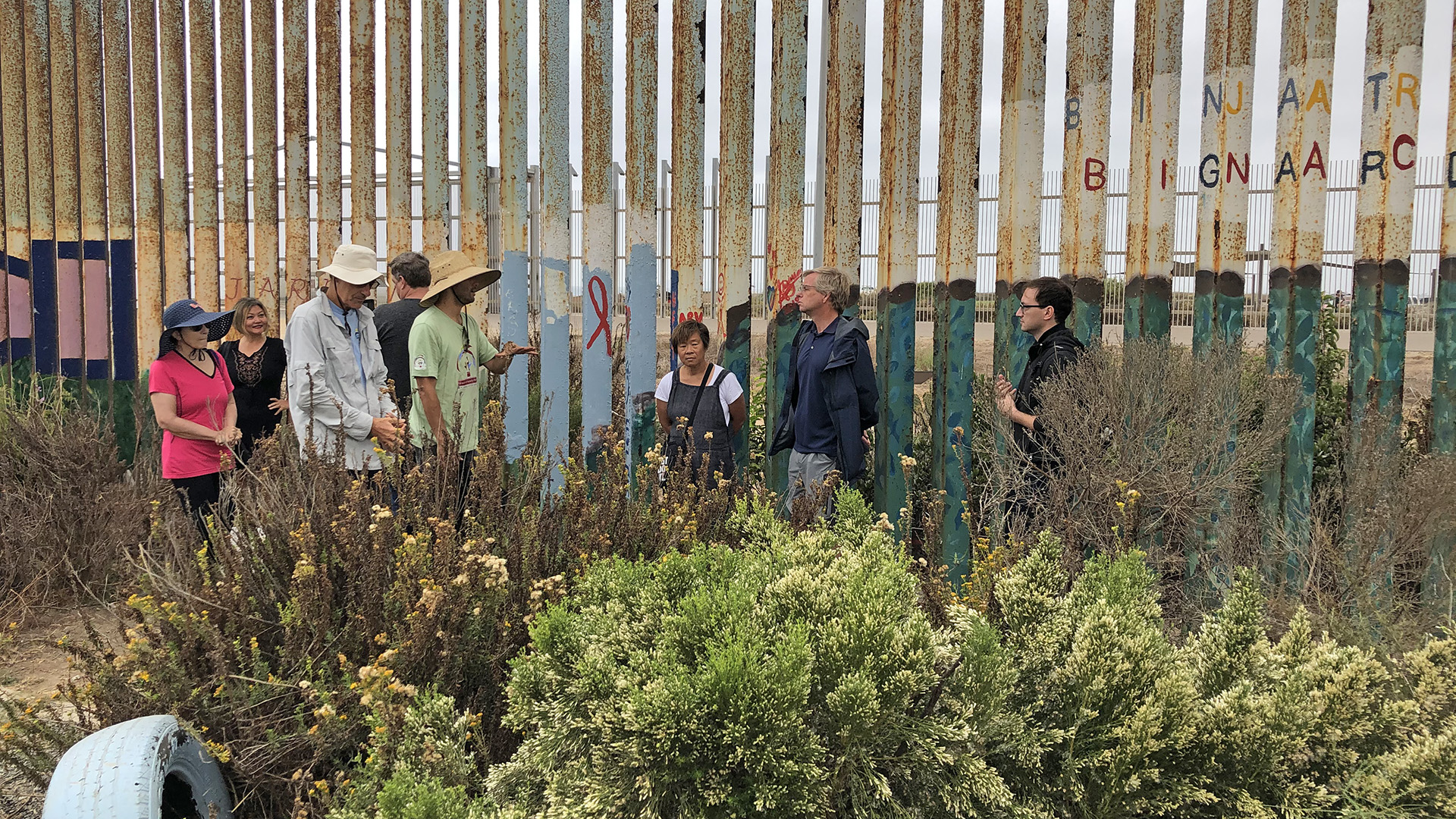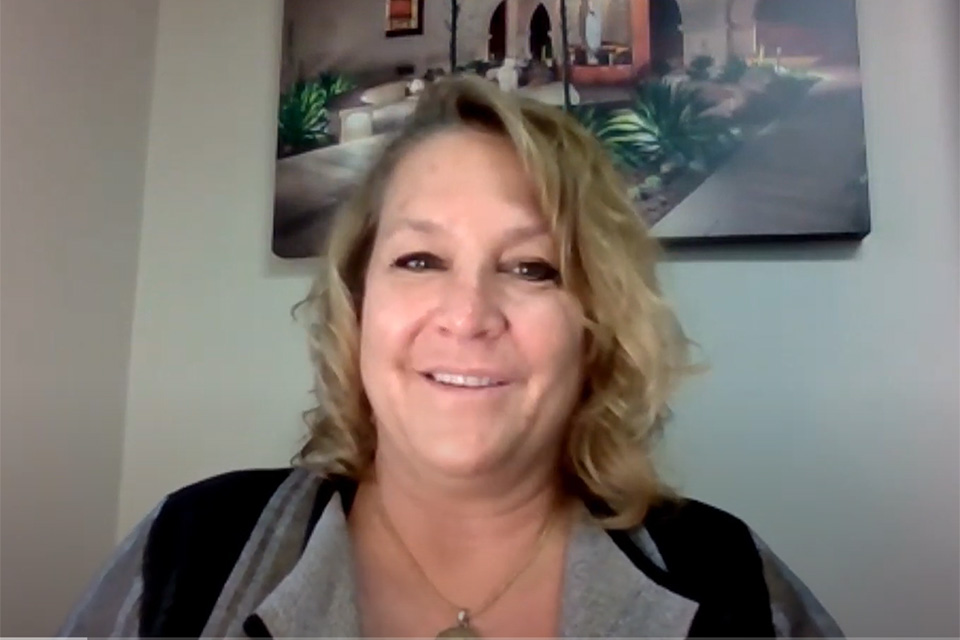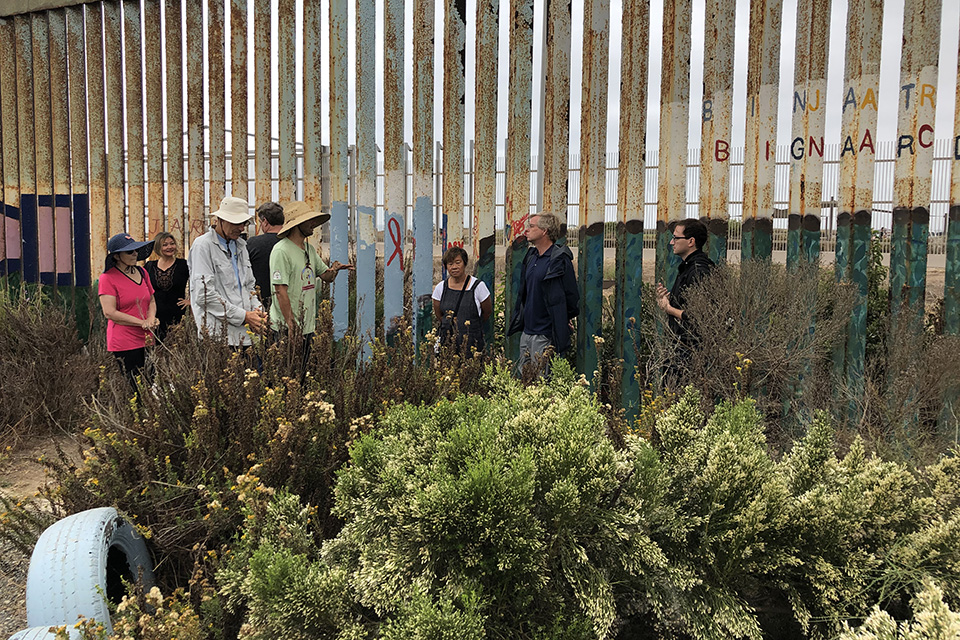Located at the westernmost end of the U.S.-Mexico border where San Diego, California, meets Tijuana, Mexico, Friendship Park and Monument Mesa is an important bi-national cultural landscape established in 1971 to demarcate the physical location of the international boundary line and provide a gathering space for visitors to the border. Although the park is listed on the National Register of Historic Places and protected by Section 106, the passage of the Real ID Act in 2005 waived all cultural, environmental, and historic protections for border construction projects, and the U.S. side of the Friendship Park garden was subsequently destroyed by U.S. Customs and Border Protection in 2019.
History
Located at the westernmost edge of the United States-Mexico border where San Diego, California, meets Tijuana, Mexico, Friendship Park and Monument Mesa is an important binational cultural landscape established in 1971. It demarcates the physical location of the international boundary line and provides a gathering space for visitors to the border. The U.S.-Mexico boundary was first surveyed in 1849, following the 1848 Treaty of Guadalupe-Hidalgo, which brought an end to the Mexican-American War. A marble obelisk nearly twenty feet tall was erected by the U.S. government as a boundary marker in 1851 and quickly made ‘Monument Mesa’ a tourist attraction, transfiguring this landscape from a point of topographical interest into a platform for cross-cultural exchange and socialization. Site protection was first implemented towards the end of the nineteenth century, following incidents of vandalism. Tourists chipping off pieces of marble had disfigured the marker, which was repaired and subsequently enclosed by a fence.
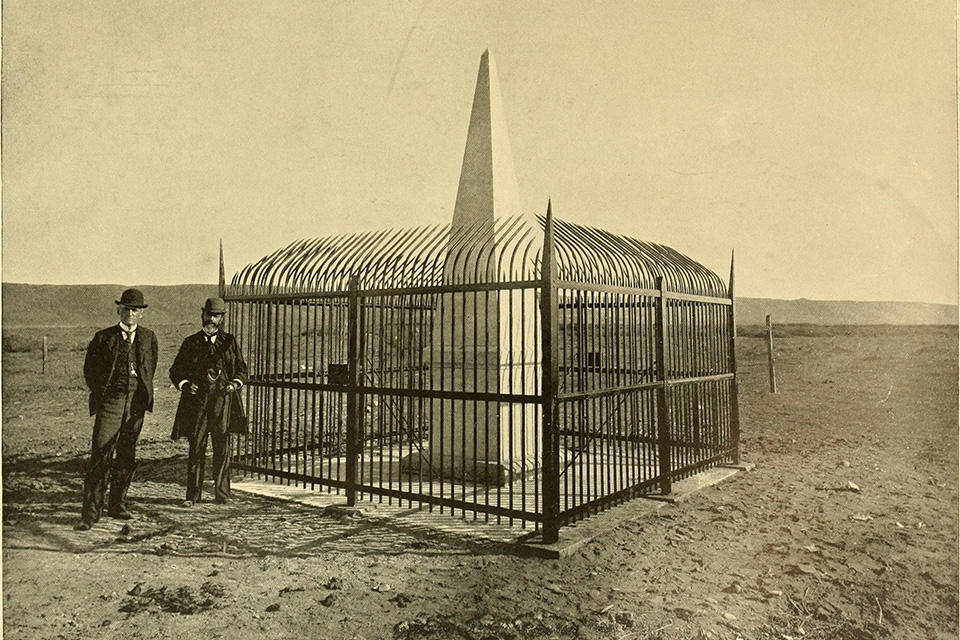 Surveyors at the boundary between the United States and Mexico west of the Rio Grande, Monument No. 258, 1898. Photo courtesy Library of Congress.
Surveyors at the boundary between the United States and Mexico west of the Rio Grande, Monument No. 258, 1898. Photo courtesy Library of Congress.
For generations, people from both sides of the border regularly crossed to surf, visit tourist attractions, and see loved ones. After World War II, a barbed wire fence was installed along the border, though Monument Mesa remained an active point of crossing and an informal site of socialization, anchored by the boundary marker.
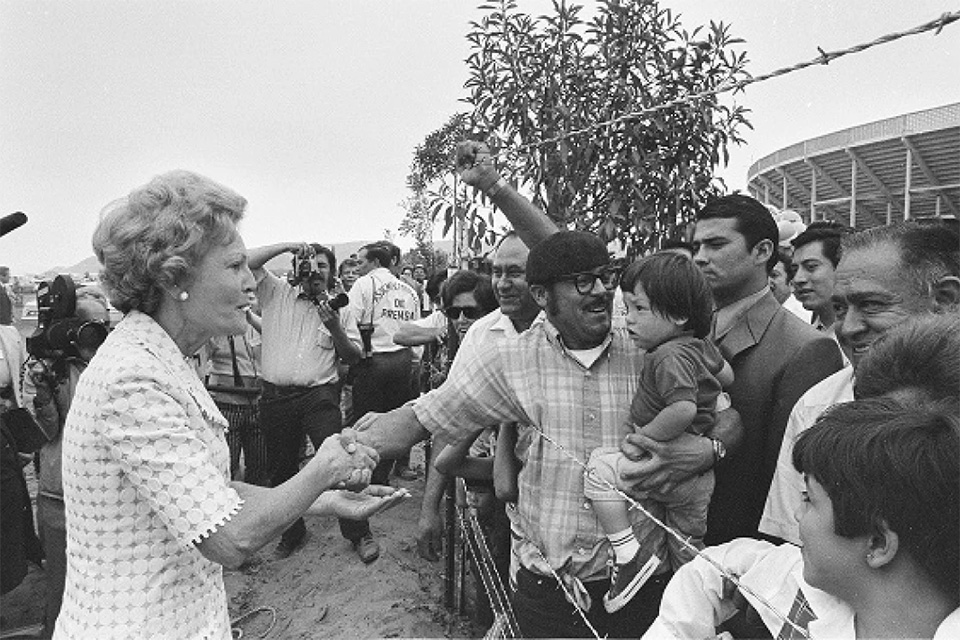 First Lady Pat Nixon at Friendship Park, 1971. Photo courtesy Nixon Presidential Library and Museum.
First Lady Pat Nixon at Friendship Park, 1971. Photo courtesy Nixon Presidential Library and Museum.
In 1971 First Lady Pat Nixon inaugurated the area surrounding Monument Mesa in the United States as California’s Border Field State Park. The First Lady asked her security detail to cut the barbed wire fence so she could step across the border into Mexico and greet the crowds who had gathered to see her, remarking, “I hope there won’t be a fence too long here.” The First Lady declared it the intention of both the United States and Mexico for this border site to be an “International Friendship Park,” modeled after similar public spaces along the U.S.-Canada border.
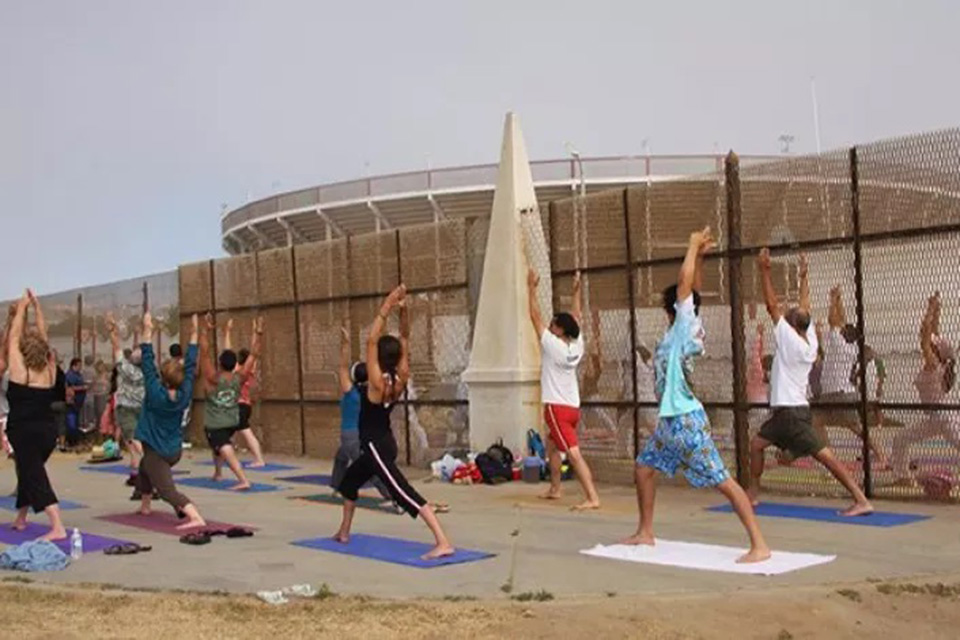 Binational yoga class at Friendship Park, 2008. Photo courtesy Maria Teresa Fernandez and Friends of Friendship Park.
Binational yoga class at Friendship Park, 2008. Photo courtesy Maria Teresa Fernandez and Friends of Friendship Park.
Throughout the 1970s and 1980s, the park remained a site for family gatherings, social events, and religious services for people on both sides of the border. In the 1990s, an economic crisis struck Mexico and led to increased illegal immigration from Mexico into the United States, and in 1994, Operation Gatekeeper was enacted by the United States Border Patrol to strengthen border security. A fourteen-mile fence was installed along the border near San Diego, running through Friendship Park. Security was heightened progressively through the 1990s and 2000s, reflecting an increase in immigration and growing anxiety around national security following the September 11 terrorist attacks. Until 2009, people on either side of the border were still able to see each other, touch, and exchange small items through the barrier. That year, Friendship Park closed as the Department of Homeland Security constructed a secondary, parallel fence fortified with a thick wire mesh, security cameras, and sensors. New, twenty-foot-tall steel bars formed a barrier leading through the beach and extending 300 feet into the Pacific Ocean. Community members and activist groups pushed back against the closure of the park and the restrictions imposed on this beloved public space, and in 2012 the federal government reopened the park with a new outer perimeter fence to control access. The United States Border Patrol heavily regulates park access.
In 2007 a binational native plant garden was established approximately 100 yards east of the border monument, in a collaborative effort by students from El Colegio de Tijuana and Kearny Mesa High School. In 2012, preparing for the construction of the new primary barrier wall, a team of landscape architects including James Brown, FAIA, native plant experts, gardeners, and community volunteers created nurseries and re-housed plants on-site at either side of the border, to be replanted after construction was completed. The garden was redesigned in a layout of circles spanning across the border, bisected by the border barrier wall, each circle planted to reflect a different theme. The Mirror Garden circle was populated by the same species on each side of the wall, illustrating the similarities that exist within the divided landscape. The Yellow Flower Garden circle, Cactus Garden, and White Sage garden each provide opportunities for visitors to engage with the ecology of their surroundings and remind guests of the connections between the people, cultures, and environments on either side of the wall.
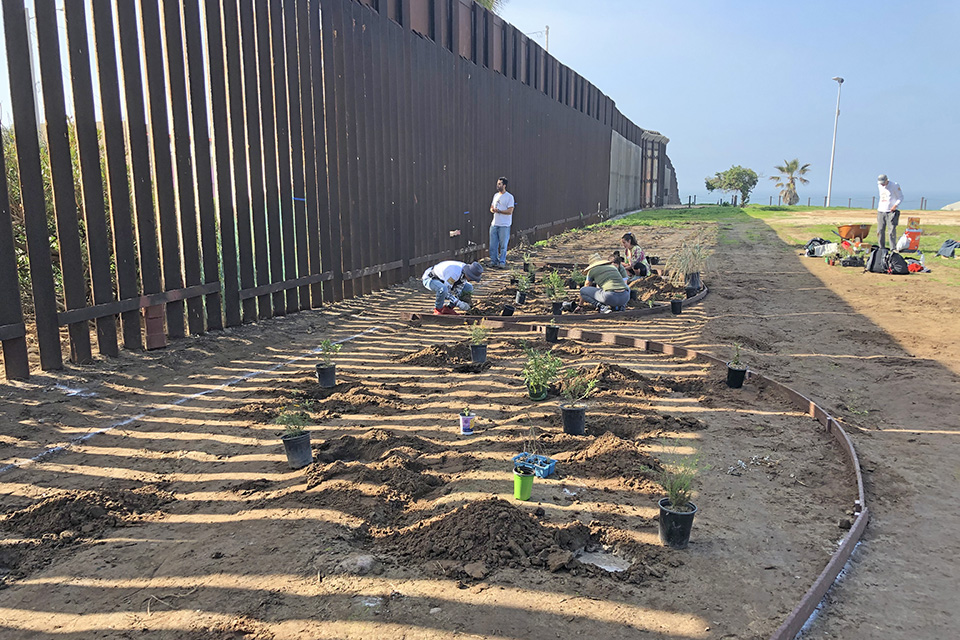 Binational garden reconstruction, 2020. Photo courtesy Michelle Landis and Friends of Friendship Park.
Binational garden reconstruction, 2020. Photo courtesy Michelle Landis and Friends of Friendship Park.
The heavily regulated access restrictions in place since 2012 were escalated by San Diego Border Patrol in 2018 to a complete prohibition. The communities were then able to negotiate limited access for garden volunteers, and the garden continued to flourish through most of 2019. In January 2020, without warning, the San Diego Border Patrol bulldozed the garden on the United States side, removing 120 deeply rooted plants and demolishing all pathways leading to and through the garden. Following local news coverage and public outrage, Border Patrol officials apologized, and allowed garden volunteers to replant the garden under supervision two weeks later. Border Patrol agents continue to heavily regulate the garden and its volunteers, and only about 40% of the newly planted native species on the United States side have survived thus far.
Friendship Park and its environs are an important cultural landscape, liminal space, and place for human interaction. The Mexico side of the park is a vibrant and colorful place that is designed to support community events and the gathering of families. In stark contrast, the U.S. side now has a different feel entirely, described by community members as reminiscent of a militarized area found in a conflict zone.

Threat
The original monument is now located on the Mexico side of the border wall, and fine mesh fencing severely limits even a visual connection to visitors on the U.S. side. As a direct result of the border wall security upgrades that were implemented in the mid-2000's in response to the 9-11 terrorist attacks, many mature park trees were cut down and access to the border wall and meeting area was severely limited and controlled by the Customs and Border Protection (CBP). Public access to the U.S. side of the park located adjacent to the border wall has been repeatedly curtailed and is currently prohibited. Previously, more human interaction was allowed and families could meet to celebrate birthdays or even to hug one another through the former fence slats, which have since been replaced by 1/4" mesh that effectively limits individuals to only touching fingertips through the tiny mesh openings when the park is open.
After the replanting of the binational native plant garden in 2020, Friendship Park volunteer gardeners were informed that the garden would be removed once again to make way for additional border wall upgrades (under the previous presidential administration).
The park, and other border facilities, have remained closed by the Department of Homeland Security since 2020 due to public health concerns and staffing shortages. Families separated by the border, community groups, and even Congressman Juan Vargas have begun speaking up to encourage the re-opening of Friendship Park. U.S. Border Patrol has responded by reiterating that they lack the resources and personnel to staff the park, and as of late 2021, there is no timeline for the park’s reopening.
What You Can Do to Help
Write to Congressman Juan Vargas and Senators Alex Padilla and Dianne Feinstein and encourage them to support the re-opening of the park.
2244 Rayburn House Office Building, Washington, D.C. 20151
Phone: (202) 225-8045
E: https://vargas.house.gov/contact
112 Hart Senate Office Building, Washington, D.C. 20510
Phone: (202) 224-3553
E: https://www.padilla.senate.gov/sontact/contact-form/
331 Hart Senate Office Building, Washington, D.C. 20510
Phone: (202) 224-3841
E: https://www.feinstein.senate.gov/public/index.cfm/e-mail-me
Donate to Friends of Friendship Park to support their efforts to renew the park’s purpose as an inviting, binational public park.
